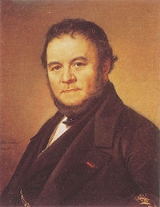
Stendhal syndrome
Encyclopedia
Stendhal syndrome, Stendhal's syndrome, hyperkulturemia, or Florence syndrome is a psychosomatic illness
that causes rapid heartbeat, dizziness, fainting, confusion and even hallucination
s when an individual is exposed to art
, usually when the art is particularly beautiful or a large amount of art is in a single place. The term can also be used to describe a similar reaction to a surfeit of choice in other circumstances, e.g. when confronted with immense beauty in the natural world.
 The illness is named after the famous 19th-century French author Stendhal
The illness is named after the famous 19th-century French author Stendhal
(pseudonym of Henri-Marie Beyle), who described his experience with the phenomenon during his 1817 visit to Florence
in his book Naples and Florence: A Journey from Milan to Reggio.
Although there are many descriptions of people becoming dizzy and fainting while taking in Florentine art, especially at the Uffizi
, dating from the early 19th century on, the syndrome was only named in 1979, when it was described by Italian psychiatrist Graziella Magherini
, who observed and described more than 100 similar cases among tourists and visitors in Florence.
Psychosomatic illness
Psychosomatic medicine is an interdisciplinary medical field studying the relationships of social, psychological, and behavioral factors on bodily processes and well-being in humans and animals...
that causes rapid heartbeat, dizziness, fainting, confusion and even hallucination
Hallucination
A hallucination, in the broadest sense of the word, is a perception in the absence of a stimulus. In a stricter sense, hallucinations are defined as perceptions in a conscious and awake state in the absence of external stimuli which have qualities of real perception, in that they are vivid,...
s when an individual is exposed to art
Art
Art is the product or process of deliberately arranging items in a way that influences and affects one or more of the senses, emotions, and intellect....
, usually when the art is particularly beautiful or a large amount of art is in a single place. The term can also be used to describe a similar reaction to a surfeit of choice in other circumstances, e.g. when confronted with immense beauty in the natural world.
History

Stendhal
Marie-Henri Beyle , better known by his pen name Stendhal, was a 19th-century French writer. Known for his acute analysis of his characters' psychology, he is considered one of the earliest and foremost practitioners of realism in his two novels Le Rouge et le Noir and La Chartreuse de Parme...
(pseudonym of Henri-Marie Beyle), who described his experience with the phenomenon during his 1817 visit to Florence
Florence
Florence is the capital city of the Italian region of Tuscany and of the province of Florence. It is the most populous city in Tuscany, with approximately 370,000 inhabitants, expanding to over 1.5 million in the metropolitan area....
in his book Naples and Florence: A Journey from Milan to Reggio.
Although there are many descriptions of people becoming dizzy and fainting while taking in Florentine art, especially at the Uffizi
Uffizi
The Uffizi Gallery , is a museum in Florence, Italy. It is one of the oldest and most famous art museums of the Western world.-History:...
, dating from the early 19th century on, the syndrome was only named in 1979, when it was described by Italian psychiatrist Graziella Magherini
Graziella Magherini
Graziella Magherini is an Italian psychologist, at the Santa Maria Nuova Hospital in Florence, Italy.-Biography:Graziella Magherini is most well known for her 1989 book La sindrome di Stendhal , which introduced this term to indicate a psychosomatic illness affecting individuals when exposed to art...
, who observed and described more than 100 similar cases among tourists and visitors in Florence.

